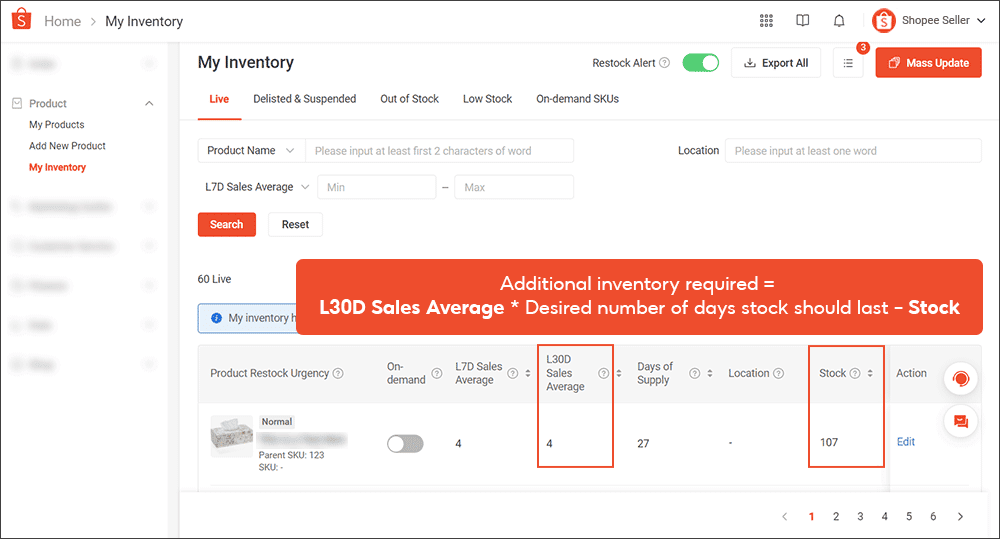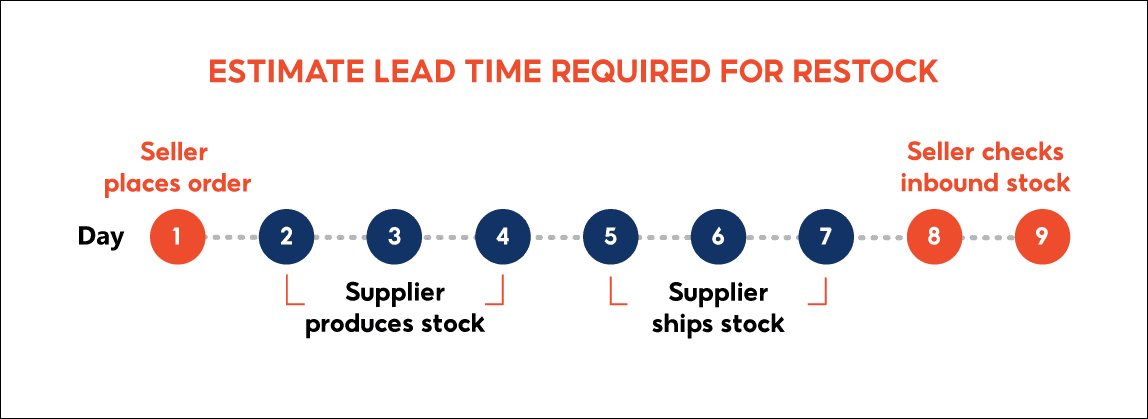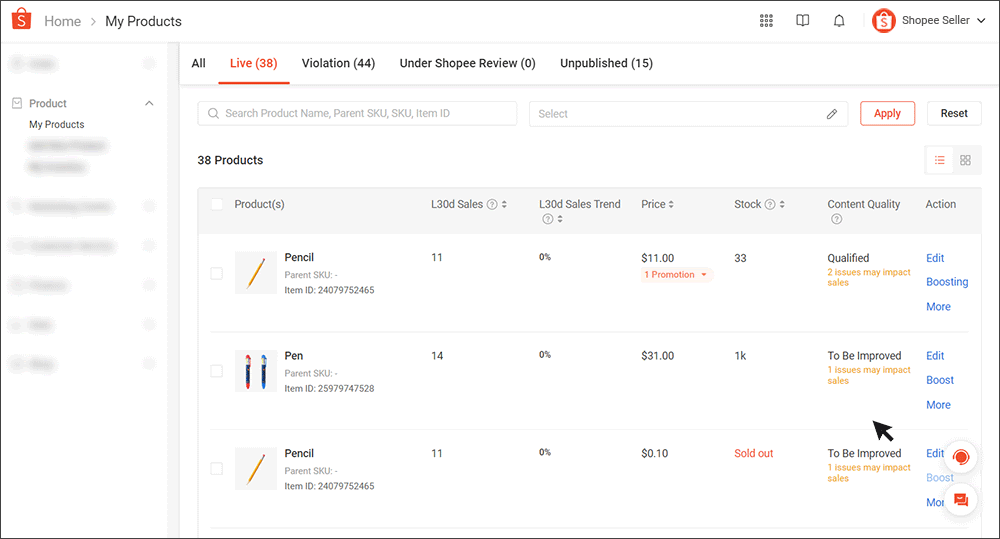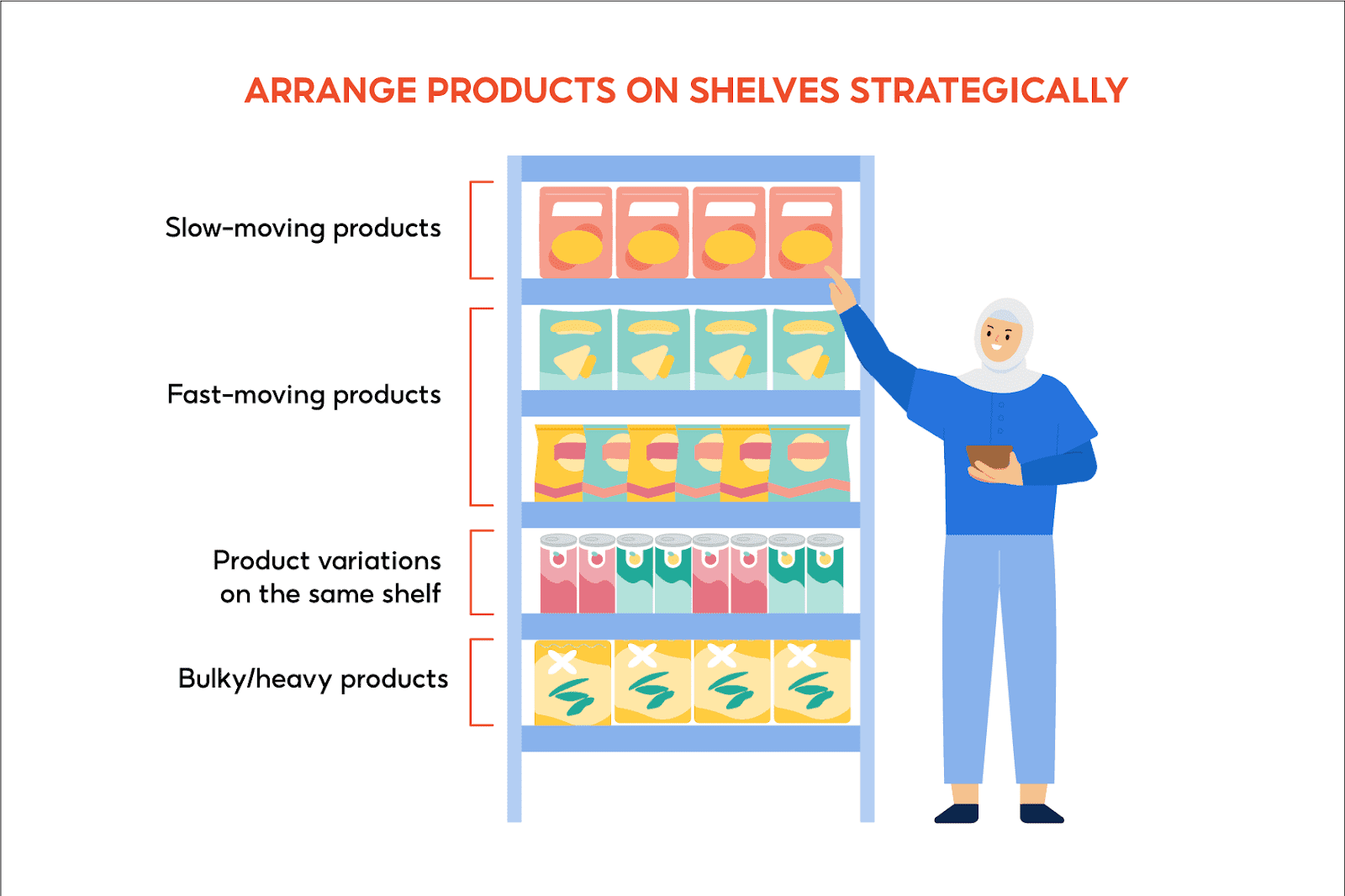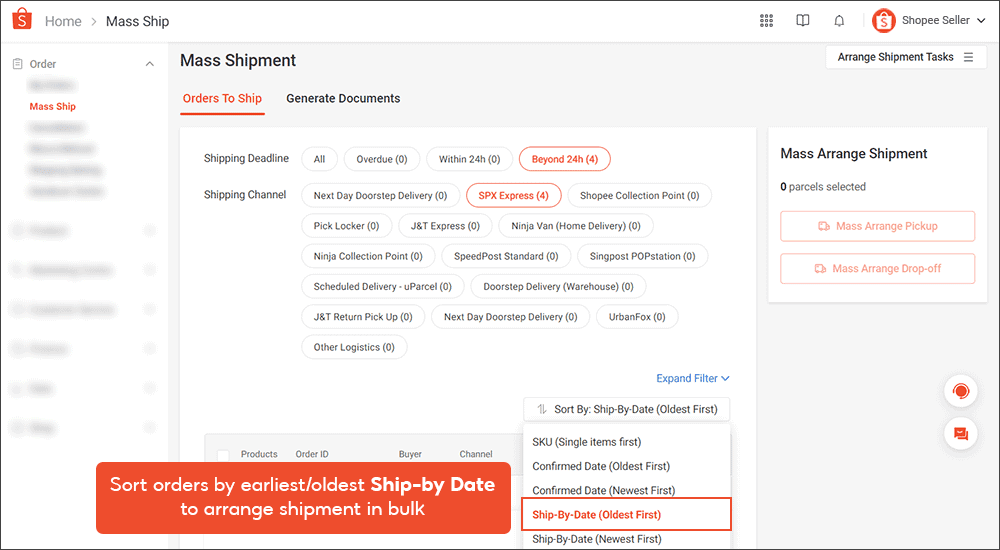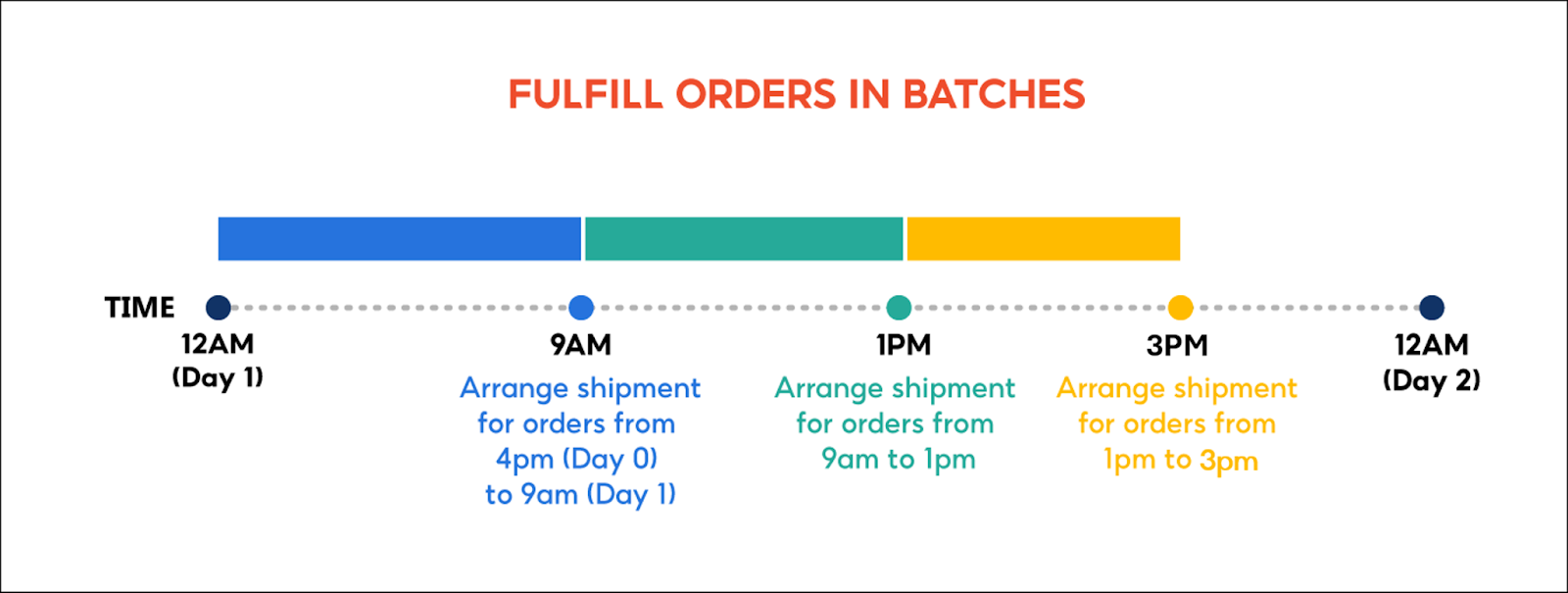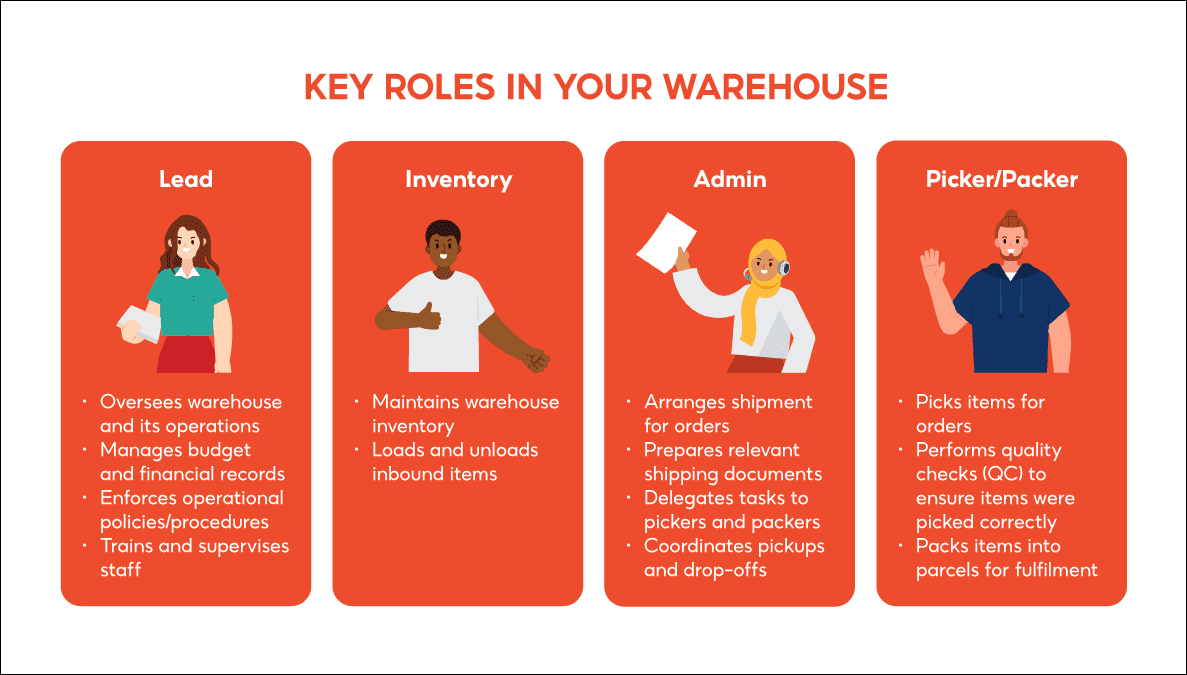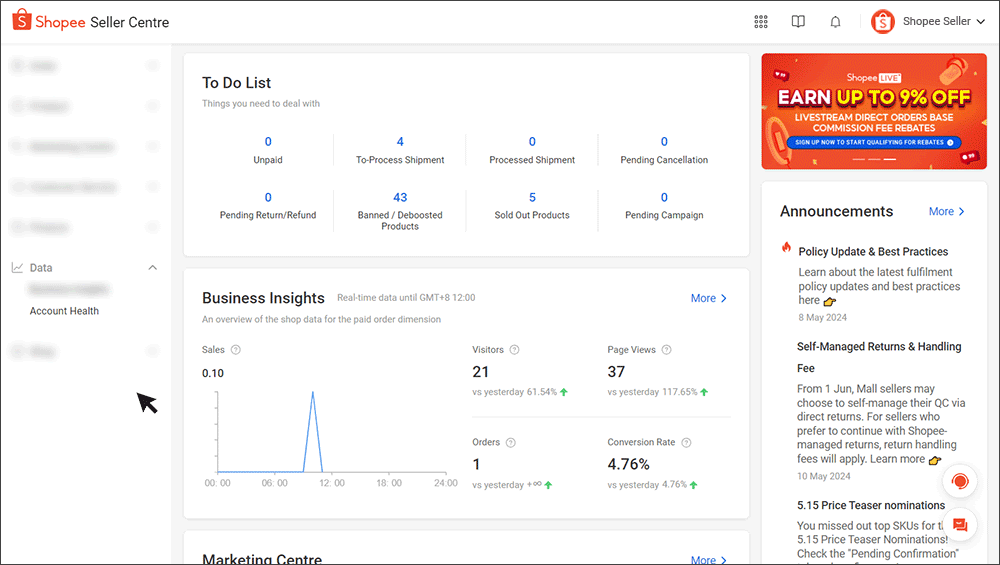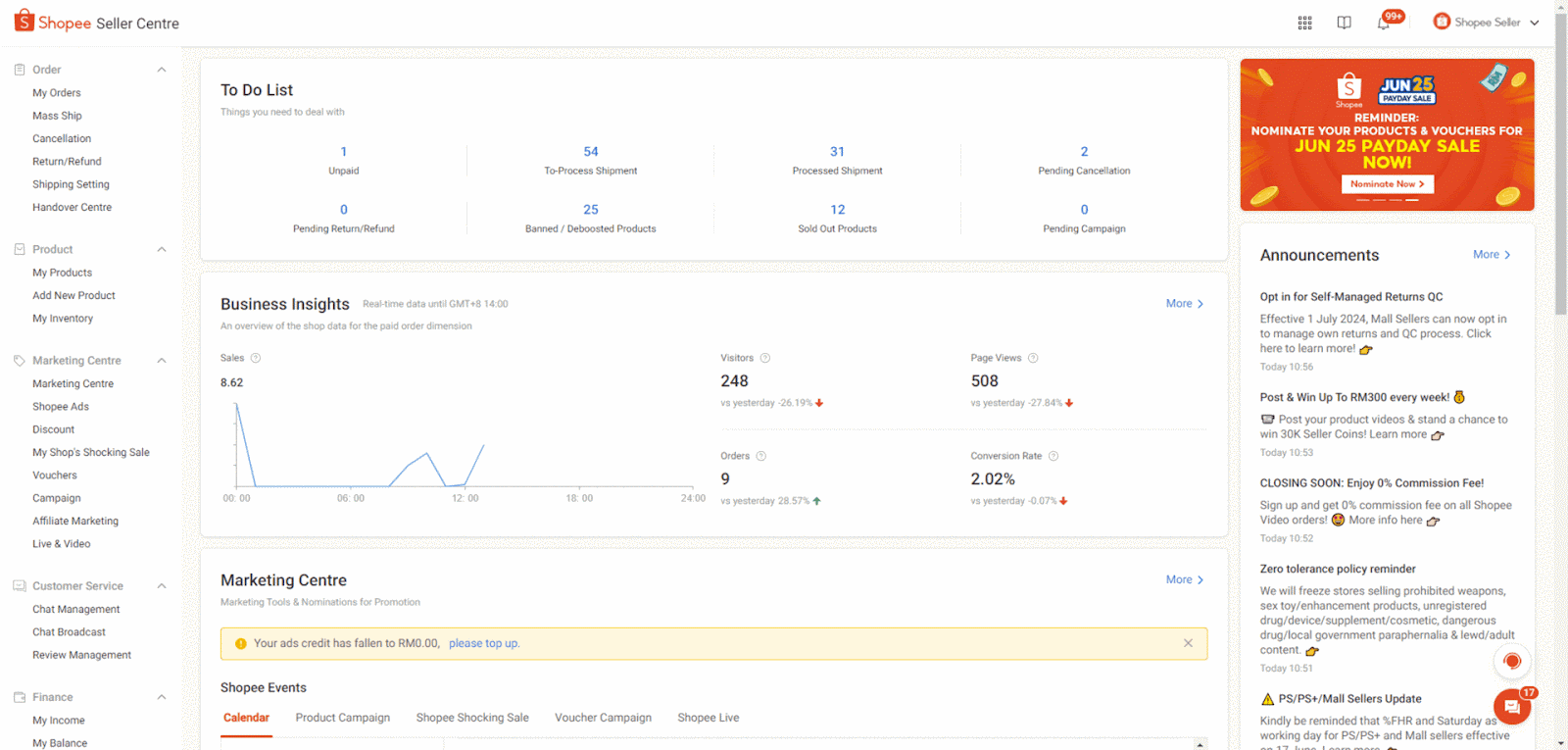Shipping fast increases the chances of parcels reaching buyers within a shorter amount of time, which boosts buyer satisfaction and creates a positive impression for your shop.
To ship fast requires consistent effort that starts even before order fulfilment. There are steps you can take even prior to getting orders, which will prepare and enable you to ship faster during the fulfilment process.
In this lesson, you'll learn how to
- Manage your stock and project future buyer demand.
- Maintain a neat and organised warehouse that facilitates smoother picking and packing, as well as handover to logistics partners.
- Conduct manpower planning and build a structured, motivated team to support your business needs.
Good stock management helps you to stay on track and ensure you will be able to meet upcoming demands. Here are 5 ways you can improve your stock management to better support fast shipping:
MANAGING STOCK
1. Track daily additional stock required using My Inventory (selected sellers only)
Use the following formula to calculate how much additional inventory is needed for an item: Additional inventory required = Average daily orders of the item (L30D Sales Average) * Desired number of days stock should last you - Available stock (Stock)
⚠️ Note
- When calculating the desired number of days the stock should last, you should take into account the number of days required to obtain the stock from your supplier.
- For example, you want the incoming stock to last you for a week (7 days). It usually takes 3 days from placing an order with the supplier to receiving the stock from them.
- Hence, the number of days the stock should last you should be 10, instead of 7. This is to account for the 3 days you'll need to tide over while waiting for the next restock.
2. Estimate product demand on a weekly basis
Demand estimation refers to the use of historical data to predict future demand. You should take into account these 4 key factors:
- Historical trends - when does demand for your product usually peak during the month/quarter/year?
- Market trends - how has the demand for your product changed in the past year?
- Platform trends - how has the demand for your product been affected by platform changes, such as monthly campaigns?
- Seasonal trends - is your product affected by seasonality, such as changes in weather?
3. Know the lead time required for restock
It is crucial to know the lead time required for restock to avoid unexpected out-of-stock situations, which will affect your ability to ship fast.
Let's see how lead time for restock can be calculated:
- Seller A sells packaging materials, which they obtain from a supplier.
- Seller A contacts the supplier on 1 August to place an order for duct tape.
- The supplier starts producing duct tape on 2 August and the production process lasts 3 days.
- The supplier starts the delivery on 5 August and it takes 3 days to arrive at Seller A’s warehouse.
- Seller A takes 2 days to complete the inbound process, quality control, and restocking the product on the shelves.
- In total, it took 1 + 3 + 3 + 2 = 9 days
- Time required for Seller A to place order with supplier = 1 day
- Time required for the supplier to process ordered goods = 3 days
- Time required for stock to be delivered from supplier to Seller A = 3 days
- Time required for Seller A to complete the inbound process = 2 days
- Based on the scenario above, the lead time for Seller A's duct tape product is 9 days. To avoid running out of stock. Seller A must start restocking at least 9 days ahead.
4. Remove/Delist listings without daily stock to avoid cancellation / delays
If a product has no stock and you have no plans to restock and continue selling, you should delete the listing entirely.
If a product has no stock but you are in the midst of restocking, you should delist the product temporarily to avoid not being able to fulfil new orders. For example, you may have incoming stock that is in transit from the supplier, held in customs, or not stored in the warehouse.
5. Set pre-order listings and longer Days to Ship (DTS) for custom items
Custom items usually require a longer preparation time, which contributes to a longer fulfilment process overall. Setting them as pre-order listings with longer Days to Ship (DTS) lets you have more time to prepare the customised products.
6. Use third-party fulfilment software (if applicable)
If you are selling across multiple platforms, consider using third-party fulfilment software to have a better overview and manage your stock easily across different platforms.
OPTIMISING YOUR WAREHOUSE
A well-organised and neat warehouse makes it easier for staff to find the things they need, thus optimising the pick-and-pack process. Here's an example of how you can arrange your warehouse for better accessibility and efficiency:
Let's dive into the best practices you can adopt for warehouse management:
1. Keep your inbound and outbound area separated clearly
To avoid confusion or clutter, keep your inbound (incoming stock, return parcels) and outbound (outgoing parcels) areas separate.
If you are unable to maintain 2 separate areas (e.g. due to space constraint), you can have clear labels or separate storage boxes to hold inbound and outbound items.
2. Provide a clear layout of the warehouse for staff
It is important to provide a clear layout/map of your warehouse to help your staff navigate easily, especially for new or contract staff who may find it difficult to locate items at the beginning. You can even label each shelf for more clarity, such as the type of product or product categories.
3. Increase accessibility of best-selling products
Place best-selling products on the shelves closest to the packing area, at body/torso height to facilitate easy access.
You can also pre-pack best-selling products for single-item orders. This would help to speed up the fulfilment process when there is a high volume of such orders, where packers would simply need to paste the Air Waybill (AWB) on pre-packed orders and they’re ready for handover.
4. Arrange products on shelves for better accessibility
How to best arrange products on shelves would depend on your shop's products and sales strategies: For example:
- Keep slower-moving products (less sales) at top shelves.
- Keep variations of a product on the same shelf.
- For products with shelf life, place stock with shorter shelf life at the front so that they get shipped first.
- If you're selling heavier/bulky products, put them in lower shelves and closer to the packing area so that it's easier to move them.
- If your shop has certain promotions (e.g. gift with purchase, bundle deals), consider putting them together so that it's easier for picking and less likely to be missed out.
- If you are using racks or stackable bins, label them clearly as well to reduce chances of picking the wrong items.
Arranging shipment is one of the most crucial stages in the order fulfilment process. Following certain guidelines, such as First In First Out (FIFO), helps to ensure orders are fulfilled efficiently.
ARRANGING ORDER FOR SHIPPING
⚠️ Note
First In First Out (FIFO) follows the principle where the order with the earliest confirmation date or Ship-by Date should be shipped first, followed by the rest in chronological order, to prevent late shipment.
1. Arrange shipment in bulk with Mass Ship
Use the Mass Ship tool on Seller Centre to arrange shipment in bulk instead of individually. When doing so, sort your orders by Ship-by Date and arrange shipment based on the earliest Ship-by Date.
2. Arrange shipment for orders 4-5 hours before closing time
To ensure that there is enough time for packing and for logistics pickup/drop-off, it is best to arrange shipment 4-5 hours before closing time. For example, if you close at 9pm, try to arrange shipment by 4pm on the same day.
In relation to Fast Handover Rate, although orders that come in after the cut-off time (COT) for the day (Day 1, 2pm) can be handed over the following day (Day 2, 11:59pm), you should strive to ship out as much as possible before the day ends. This is to reduce load for the following day and provide a buffer for potential new orders.
3. Book and fulfil orders in batches
Fulfil orders in batches based on the FIFO principle, ensuring earliest orders get shipped out first. This segregation into batches also prevents mixing of older and newer orders, which can result in confusion and failed handovers.
For example, if you are either a Preferred, Preferred+, or Mall seller shipping with SPX Express, you can arrange shipment and fulfil orders every 2-4 hours:
- Arrange shipment at 9am (Day 1) to fulfil orders created during 2pm (Day 0) to 9am (Day 1)
- Arrange shipment at 1pm (Day 1) to fulfil orders created during 9am (Day 1) to 1pm (Day 1)
- Arrange shipment before 3pm (Day 1) to fulfil orders created during 1pm (Day 1) to 3pm (Day 1)
4. Check and respond to cancellation requests regularly
Check for cancellations regularly to exclude them from order preparation in a timely manner, so that you can prevent wastage of time and resources.
5. Auto-arrange shipment via Warehouse Management System (WMS)
For sellers using third-party fulfilment software, enable auto-arrange shipment for your preferred working days and hours. For example, you can set pickup hours up till 1 hour before your shop's closing time, to ensure orders that need to be fulfilled the following day can be picked up as early as possible.
STRATEGISING PICK AND PACK AND HANDOVER PROCESS
For efficient picking, packing, and handover, it is important that you have a trained team to support you at the warehouse, with these keys roles:
⚠️ Note
- This is a guideline on key roles required. Depending on your business needs, each role may have 1 or more persons involved, or you may have other roles.
- For example, you may have one person doing both picking and packing instead of having separate pickers and packers.
It is pivotal to have someone in charge of coordinating these key processes:
- Arranging shipment
- Printing shipping documents (e.g. Air Waybill)
- Matching and sorting orders' Air Waybills into boxes (e.g. recycled cardboard boxes) for easy assignment
- Delegating orders to pickers and packers.
Building a strong foundation like this goes a long way in streamlining the fulfilment process.
Tips for sorting and delegating orders for pick-and-pack
At this point, orders should have been arranged in batches for shipment, based on Ship-by Date. Here’s how you can further sort them to expedite picking and packing:
- Prioritise orders within each batch based on the following priorisation:
- Priority 1: Orders for past deadline, instant/same-day/next-day delivery
- Priority 2: Orders that need to be shipped within 24 hours, or by COT
- Priority 3: Orders that can be shipped after 24 hours
- Split into single-item and multiple-item orders within each batch
- On the Mass Ship page, sort orders by SKU (Single Items First)
- Single-item orders should be packed first as they can be completed faster.
- To speed things up, you can consider assigning all single-item orders to one person for picking and packing.
Tips for picking / packing
- Use cardboard or plastic boxes / trays to put picked products for each order. Keep each order’s Air Waybill (AWB) in their respective boxes for easier quality check (QC) later on, before packing starts
- Store all packaging materials together in one area, ensuring there is enough supply for at least 1 round of packing
- Divide packaging area by product type e.g. fragile products, spillable products, high-value products
- Follow Shopee Packaging Guidelines
- Check for proper AWB print quality and orientation so that parcels can be scanned successfully during handover
Tips for Pickup Handovers
- Ensure orders booked for pickup are ready for handover during actual pickup
- Keep pickup address and contact information updated so that logistics partners have the right address
- Separate Same Day Delivery parcels from Doorstep Delivery parcels to facilitate smooth pickup
- Separate parcels for pickup by different logistics partners, ensuring that you label them clearly. If your warehouse has space, you can:
- Further divide the parcels by pickup timing (e.g. Group A is to be handed over today, Group B for tomorrow)
- Position the outbound area near the warehouse exit/entrance to avoid congestion/clutter and allow easier access for logistics partners
- Ensure that the pickup driver scans the parcels on the spot to acknowledge receipt
- Contact the pickup driver using the contact number shown on Handover Centre if they have not shown up for pickup and it is near your shop's closing time
- Keep records of rescheduled and failed pickups when pickup drivers fail to turn up
⚠️ Note
- If you encounter issues for pickup, reach out to the logistics company directly.
- We're proactively excluding cases of non-seller fault for fairer evaluation of seller performance (e.g. Non-fulfilment Rate, Late Shipment Rate, Average Preparation Time, or Fast Handover Rate). If you feel you have been wrongly penalised because Shopee Supported Logistics partners failed to pick up your orders or picked up your orders late, you can submit an appeal.
Tips for Drop-off
- Know the operating hours and location of your nearest drop-off location
- Drop off parcels that were not picked up as intended so that they can still be fulfilled in a timely manner
- Ensure that drop-off points scan parcels on the spot to acknowledge receipt
PLANNING MANPOWER AND OPERATION HOUR
During campaigns or busier hours, such as after Shopee Shocking Sale, it is recommended that you hire contract staff to ensure that orders are fulfilled in a timely manner. Hiring contract staff on a needs-only basis prevents you from incurring inefficiency from having excess staff.
Here is how you can maintain and train a team of staff to support you:
1. Estimate manpower required using demand forecast
It is important to know how many people you will need to support your fulfilment needs, especially during peak campaign periods and pay-day / mid-month spikes. Here is how manpower demand forecast can be done:
- Know your average daily order: how many completed orders do you get daily based on the last 30 days?
- Find out your current capacity: based on your current manpower, how many orders can 1 person fulfil in a day? (e.g. 1 picker can pick for 60 orders per day, 1 packer can complete 50 orders per day)
- Use historical data to estimate the demand expected for busier periods
- Forecast how many additional people will be needed to cope with the estimated demand, based on your current productivity
For example:
- Based on the number of orders fulfilled in the last 30 days, you estimate that 1 packer can complete 50 orders on a daily basis. You have a total of 3 packers.
- Using historical data, you predict that orders during the pay-day campaign will reach 300 a day.
- You should hire 4 to 5 more contract staff to support the packing, assuming that they can pack about 30 orders each day. Do take into consideration that new joiners might not be able to perform as well as the seasoned packers you have.
You might want to consider hiring more contract staff during busy periods that you cannot afford to underperform, such as year-end mega campaigns, as there needs to be a buffer for unforeseen circumstances (e.g. staff falling sick, staff leaving).
2. Introduce a rotation system
Conduct cross-training so that each staff has skills to handle more than one type of work, and is able to support other functions when required.
For example, if your pickers are also trained in packing, they can help to pack orders once they’re done picking for orders that need to be fulfilled within the same day. Or, to prepare for the last pickup of the day, you could pause the picking process and get everyone to focus on packing orders so they can all be handed over successfully within the same day.
3. Set up an incentive system
A performance-based reward system can help to boost morale and productivity. For example, you can give monetary incentives to top-performing staff, based on the number of orders they picked/packed accurately within a day, or number of orders completed on time within a day.
This can motivate staff to perform better and reduce chances of turnover.
4. Keep your operating hours updated and feasible
You are encouraged to keep warehouse opening hours flexible and extend them if needed during busier periods.
- Ensure shop operating hours on Seller Centre are updated correctly to avoid failed pickups due to logistics partners arriving at non-working hours
- Keep your warehouse open until the latest courier pickup time
- Consider working on weekends to clear backlog so buyers can get their orders on time
- Enable Vacation Mode when your shop is not operational for an extended period of time (e.g. long holiday)
- Consider working overtime or hiring contract staff during campaign periods to handle higher volume of orders
MONITORING YOUR PERFORMANCE
To improve your fulfilment performance, it is important to monitor it regularly and identify any issues that need to be resolved. Account Health on Seller Centre lets you:
- Monitor weekly performance of key metrics: Non-fulfilment Rate (NFR), Late Shipment Rate (LSR), Average Preparation Time (APT), Fast Handover Rate (FHR)
- Submit an appeal within 14 days if you have been wrongly penalised (e.g. due to logistics partner fault)
You can also monitor pickup handovers via Handover Centre and provide feedback to the logistics company. Take note that fulfilment is a complicated process so it can be common for logistics issues to occur, due to the multitude of external factors that can affect the process. You can always submit an appeal if you have been wrongly penalised.



